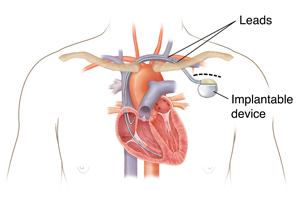Understanding Replacement of an Implantable Heart Device
Implantable heart devices help control the heart’s rhythm. Some are pacemakers. Some are ICDs (implantable cardioverter defibrillators). You have one now. It was implanted (placed) in your body in the past. You may have wires (leads) that connect it to your heart muscle. You now need your device to be replaced.

Why do I need my implantable heart device replaced?
An implantable heart device runs on a battery. This battery can last for a few years or more. The battery life depends on how often your device is working to control your heart rhythm. A meter lets your health care provider know when the battery is low. When it has only a few months of energy left, getting a new device is advised. If the battery runs out, the device may not work right or may go into its low energy mode. A device may have to be replaced sooner if it stops working right, or if you get an infection.
What happens when my implantable heart device is replaced?
The procedure to replace your device is shorter and simpler than when it was first placed. It's often done on an outpatient basis (you can go home the same day). In many cases, only the generator needs to be replaced. If the wires (leads) that connect the device to your heart are working right, you won't need new ones.
What happens:
-
The skin over the device is sterilized and draped.
-
A new incision (cut) is made over the old one.
-
The device is removed from its pocket.
-
The leads are checked to make sure they work right.
-
The health care provider removes the old device from the leads.
-
The provider attaches the new device to the leads. This is tested to make sure it works right.
-
The device is put back under the skin.
-
The cut is closed.
-
The provider programs the device’s settings to correctly help your heart.
What are the risks of replacing an implantable heart device?
The most common serious risk is infection. Other risks include:
Online Medical Reviewer:
Stacey Wojcik MBA BSN RN
Online Medical Reviewer:
Steven Kang MD
Date Last Reviewed:
11/1/2024
© 2000-2025 The StayWell Company, LLC. All rights reserved. This information is not intended as a substitute for professional medical care. Always follow your healthcare professional's instructions.